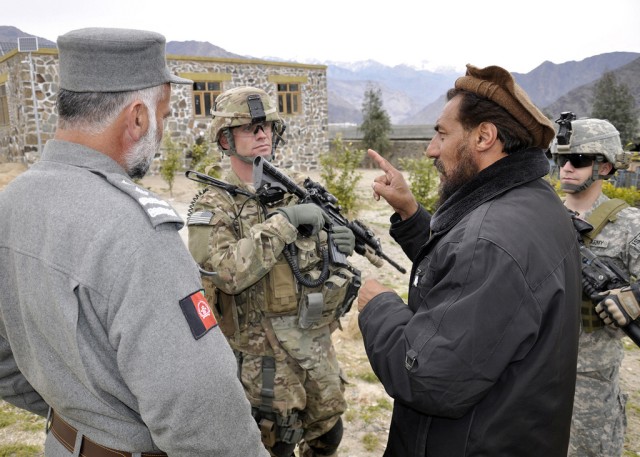
WASHINGTON, Feb. 24, 2011 -- The Afghan army is growing fast and simultaneously struggling with the need to educate and train its noncommissioned officer corps, the senior enlisted leader of NATO's International Security Assistance Force and U.S. Forces Afghanistan said today.
Command Sgt. Major Marvin Hill and his Afghan counterpart, Sgt. Maj. Roshan Safi, spoke with reporters at the Pentagon during a video teleconference from ISAF Joint Command headquarters in Kabul, Afghanistan.
"The Afghan National Army, like the entire [Afghan security forces], has come a long way in just a short period of time," Hill said.
The Afghan security forces include the army, the air force and the national police.
Since 2009, the army has grown more than 56 percent, Hill said. In the past year, it's grown by about 50,000 soldiers, more than 23,000 of them are in training, and the army consistently meets its recruiting goals, he added.
With new programs for recruitment and retention, higher salaries, an automated pay system and an attrition rate of 1.6 percent per month, growth is not a problem, he said.
"The bigger challenge is creating an entire structure of military education and development that will professionalize the entire force," Hill said. A big part of Roshan's role is helping professionalize the Afghan army's noncommissioned officer corps, he added.
In 2009, only 86 percent of army recruits were literate, and there was no mandatory literacy training. Soldiers faced substandard pay, shortages of equipment, a poor quality of life and a high attrition rate, Hill said.
"Under Sergeant Major Roshan's leadership, there's been a 76 percent increase in trained noncommissioned officers," Hill said. "[Afghan army] NCOs are already filling key positions, such as instructors for professional courses, as well as setting the example for standards and discipline," Hill said.
Today, all soldiers receive mandatory literacy training, he added. They are are outfitted with Afghan-made uniforms, NATO weapons and high-quality equipment.
Eleven of the 12 branch schools are open -- including infantry, engineering and intelligence -- and in many case, Afghan soldiers already are taking the lead as instructors, Hill said, adding that Afghanistan's army is "built on the pride of its people."
Soldiers represent several ethnic groups, including Pashtun, Tajik, Hazara and Uzbek, Hill noted, and the army takes pride in being "the protector of the people and the nation."
As a result of support the Afghan army has received from the United States and coalition forces, Roshan said, Afghan soldiers have begun to take the lead in a number of combat operations.
"We are well on our way to taking full control and leading all combat operations by 2014," he said. "By working shoulder to shoulder today, we will stand on our own tomorrow."
Since 2009, women have served in the Afghan army, Roshan said.
"Just 10 years ago, women were not allowed to attend school," he said. "In fact, women had very little rights at the time. Now, we see women attending school, and they hold meaningful jobs in our community and position in our government."
The Afghan army's training center is training future female NCOs, he added.
In late 2009, 20 women graduated from the first female officer candidate school. Twenty more women are enrolled in school now, and women also are enrolled in the military medical school, the Afghan sergeant major said.
Challenges lie ahead for the growing army, Hill said, especially in the areas of equipment and international trainers.
"The end state is that by 2014, the [Afghan army] is a self-sufficient professional force," Hill said.
"This process will take time," he added, "but ISAF is fully committed to an enduring relationship and partnership with the Afghan National Army and the Afghan National Security Forces as a whole."
In the meantime, Hill said, protecting people is the primary concern.
"Right now, we have 110,000 more forces here in Afghanistan than we had at this time last year," Hill said. "We have 70,000 more Afghan National Security Forces, and we have 40,000 more U.S. and coalition forces. And that's providing a better umbrella of security.
"Just months ago," he continued, "the people in Marja couldn't come out of their homes. And today, bazaars are open, there are open shops and markets, and schools are open. There's a girls' school open that has 180 students, and that wasn't the case just months ago.
Security always is a problem anywhere, Hill said. "But here," he added, "we are combating that with the boots we have on the ground and with a competent Afghan National Security Force."
Related Links:
STAND-TO!: Enhanced COIN Operations
To see more photos of Soldiers in action, check out the Army's photostream on Flikr

Social Sharing